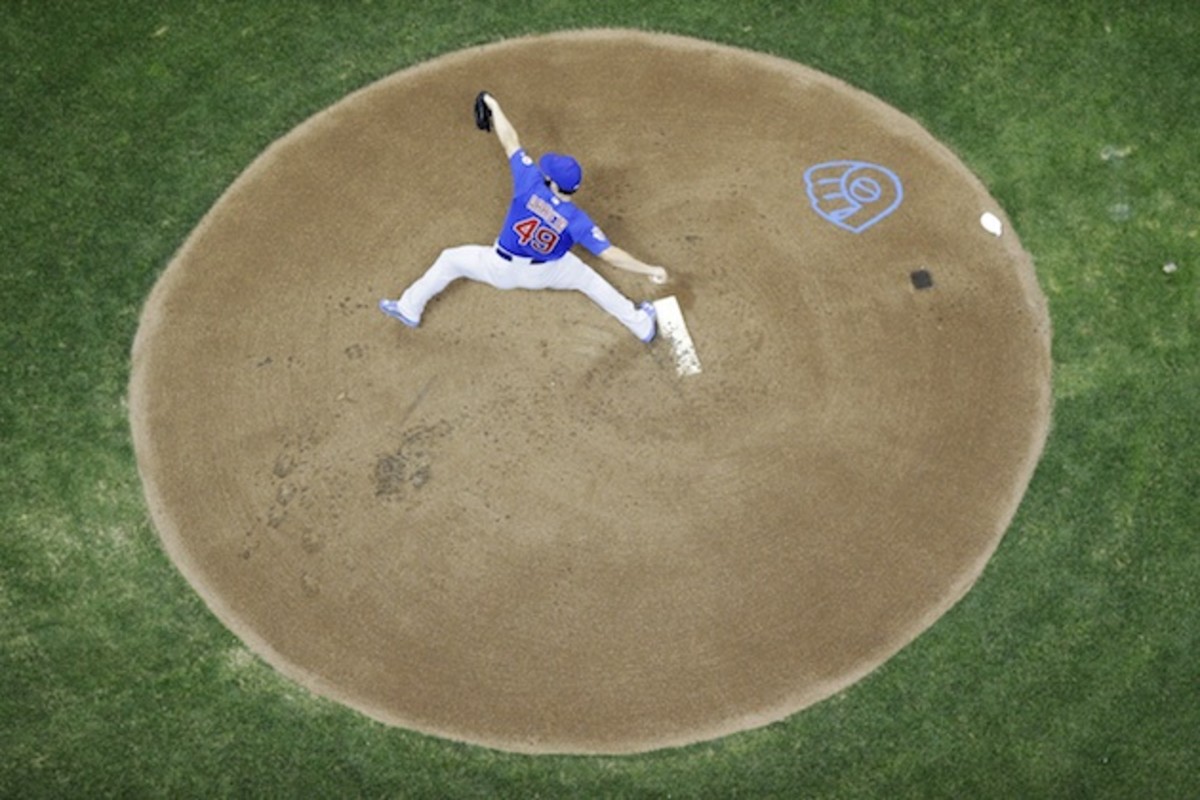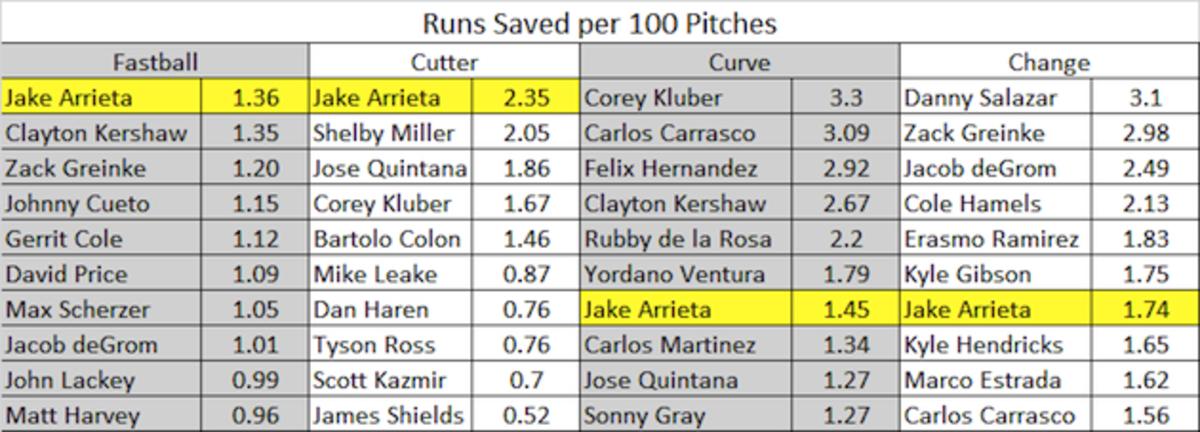Arrieta’s varied approach earns him Cy Young nod, Cubs' first since '92

No member of the Baseball Writers Association of America who cast a ballot in this year’s NL Cy Young race could justifiably be criticized for the way they filled out their trifecta. There were simply no wrong answers.
Depending on which stats you use to craft it, your argument in favor of Zack Greinke, Jake Arrieta, or Clayton Kershaw has merit to spare. But unless you’re suffering from anterograde amnesia, it’s the finish that matters most in this what-have-you-done-for-me-lately world.
Members of the BBWAA certainly felt that way, listing Arrieta in the top spot on 17 ballots and in second on 10 more. In all, he tallied 169 points, narrowly edging out Greinke (147) to become the first Chicago Cub since Greg Maddux in 1992 to take home the prestigious award.
Maybe you’ve heard enough about just how insanely good Arrieta was this season, how his 0.75 second-half ERA was the best in MLB history. Me? I don’t think I’ll ever grow tired of tales of incredible athletic achievement. Kind of like how the hirsute hurler himself never seemed to weaken, looking more machine than human down the stretch of last season.
Arrieta smashed his previous career-high innings-pitched mark of 156.2 in the second inning of his start on August 15th, and went on to throw 72.1 more innings over nine additional starts. His ERA in those final 10 games: 0.49. (Not a typo.) Compare that to his 23 previous starts, in which Arrieta tallied a pedestrian 2.38.
Pitchers are not supposed to get better as the season goes on. The grind of taking the bump every fifth day for six months should produce an entropic effect — or, at the very least, an inertial one. Makes sense, right? The higher the workload, the more velocity goes down, the less movement you get on your pitches, and so on.

Arrieta, however, was immune to that way of thinking. Rather than succumb to the torpor and apathy that have laid low so many before him, the 29-year-old ace made his calling card that of the tireless worker — fully aware, it seems, of his own baseball mortality.
When Arrieta was out dripping sweat on the mound late in a tight ballgame, though, it was borne of an effort that paled to what he had done in the days leading up to the start. He pushed his body past any career limit on the diamond by pushing his body harder off it. And we’re not talking about some staid routine of a rock-eating muscle-monster looking at baby-faced fellow pitcher Trevor Cahill and asking, “Do you even lift, bro?”
Don’t get me wrong, Arrieta is jacked. Maybe not tickets-to-the-gun-show, grunting-at-the-guy-staring-at-him-through-the-gym-mirror jacked, but not the kind of guy you, the common street thief, want to be wrestling with over his wife’s purse, either.
Whether it’s yoga, pilates, riding a bike, running, walking on his hands, or grooming the pelt on his face, Arrieta’s fitness routine is anything but rote. It’s that variation that’s kept him fit as a fiddle and pitching like a Stradivarius. Just as he was changing up his workouts throughout the season, so too had Arrieta tweaked what had become one of the filthiest pitches in all of baseball—the slider, the cutter, a more salacious pormanteau (“slutter”), whatever you want to call it.
As Eno Sarris reported for Fangraphs, Arrieta’s pitch starts with a single grip, but can have any number of different results. Here’s Arrieta talking about his approach:
I can manipulate the velocity, I can manipulate the break, depending on the situation, depending on the hitter, depending on the count ...
If I’m trying to get up under a lefty’s hands, I’ll elevate it, giving the appearance of an elevated fastball, something that hitters like a lot, but then you get that four to six inch breaks into the lefty, and by the time they commit, it’s too late ...
If I’m going for a swing and a miss late in the count against a righty, I’ll increase the break, maybe decrease the velocity to 87–88, and go for more of a slider break ...
I always had the breaking ball I have now, I just didn’t have the command of my fastball to put me in the position where I was ahead in counts, to be able to do different things with it — to be able to throw it beneath the zone for swings and misses, to be able to utilize it early in the count for strikes — it all starts with command.
Sure enough, Arrieta’s mark of 1.89 walks per nine innings in 2015 was about 20 percent better than his previous career-best mark of 2.36, set just last season. In parts of four previous big league seasons, his BB/9 numbers were 4.31, 4.45, 2.75, and 4.90. He also struck out 9.28 per nine, which adds up to a K/BB rate of 4.92. Which is, well, it’s really good.
Of course, all that wasn’t achieved solely on the virtue of a single amorphous pitch. While the cutter led the way (Fangraphs calls it as such, so we’ll stick with that for the purposes of this next stat), the Cubs ace proved himself a Jake of all trades (sorry not sorry) in displaying perhaps the best repertoire in the the game last season.
In terms of pitch value, his cutter was the best in baseball by a wide margin, saving an estimated 23.5 runs on the season. (Corey Kluber was 2nd with 15.1.) Only two other pitches — the fastballs of Clayton Kershaw (24.7) and Gerrit Cole (24.2) — saved more runs in 2015. For what it’s worth, Arrieta’s heater was worth 23.7.
Oh, and his curve and change were all outstanding as well.
Because different pitchers throw different pitches at different rates, it’s sometimes necessary to compare offerings on a standardized per-100-pitch scale in order to judge relative value. This is where Arrieta really stands out. By that measure, his fastball (1.36) was the best in the majors, barely edging out Clayton Kershaw (1.35). Meanwhile, Arrieta’s cutter (2.35) was far better than anyone else’s, with Shelby Miller’s impressive 2.05 holding second place. And he didn’t utilize them nearly as often, Arrieta’s curve and change both ranked seventh in all of baseball when adjusted for frequency.

Basically, Jake Arrieta had four pitches ranked among the top seven in Major League Baseball in terms of relative runs-saved value. To put that in perspective, no other pitcher appears in more than two of those top-10 rankings. Having such an array of devastating pitches enabled him to not only shift utilization based on the opponent, but how he was throwing each of them on a given day.
But the true key to Arrieta’s success was not as much about the bats he missed as it was what happened when hitters actually put balls in play. In short, guys just didn’t hit the ball in the air. From June 21 on, Arrieta allowed only two home runs to 518 batters — a tidy 0.39 percent clip. That’s about 87 percent less than than the league-wide home-run rate, give or take a few percentage points here or there. For what it’s worth, Arrieta hit two home runs of his own in that stretch, and in a few fewer plate appearances than 518 (I’ll check the math).
All told, Arrieta’s ground-ball rate was — warning: this is going to be hard to believe — a career-best 55.7 percent this season, up from 49.2 percent in 2014. But oh, it gets better. Over the second half of the year, Arrieta induced grounders at a 62.9 percent rate, including 67.4 percent over his last 10 starts.
In sum, he walked fewer guys, struck more out, and gave up ground balls on two-thirds of those put in play.

Yeah, that’ll help you win some ballgames. In the end, it was enough — more than enough.
Like Corey Kluber in the American League last season, Arrieta used an insane second half to go from being left off the All-Star ballot to appearing on more Cy Young ballots than perennial favorites Greinke and Kershaw. And while it certainly didn’t hurt to throw a no-hitter in a nationally-televised game at Chavez Ravine, Arrieta’s second-half surge was unlike anything in recent memory, and a microcosm of the Cubs’ unlikely, almost-fairly-tale trek.
Whether it was in the offseason or during his days off, Arrieta put in yeoman’s work to make himself a better, more consistent pitcher. That effort — constant, calculating, and unyielding — paid huge dividends, both for his team and his career. And while he’d surely trade the Cy Young for a couple more postseason starts, there are worse consolation prizes than being named the best pitcher in the National League.
The hope being, of course, that Cubs fans can look forward to Arrieta’s encore performance being the icing, rather than the cake, of Chicago’s ultimate goal.

